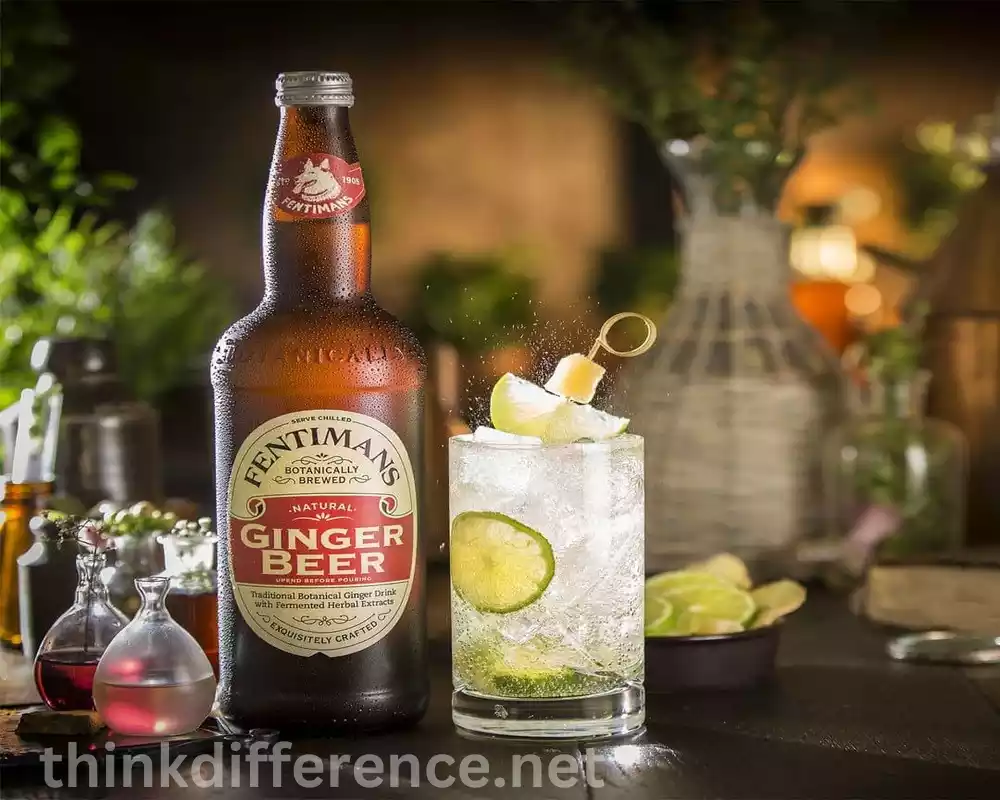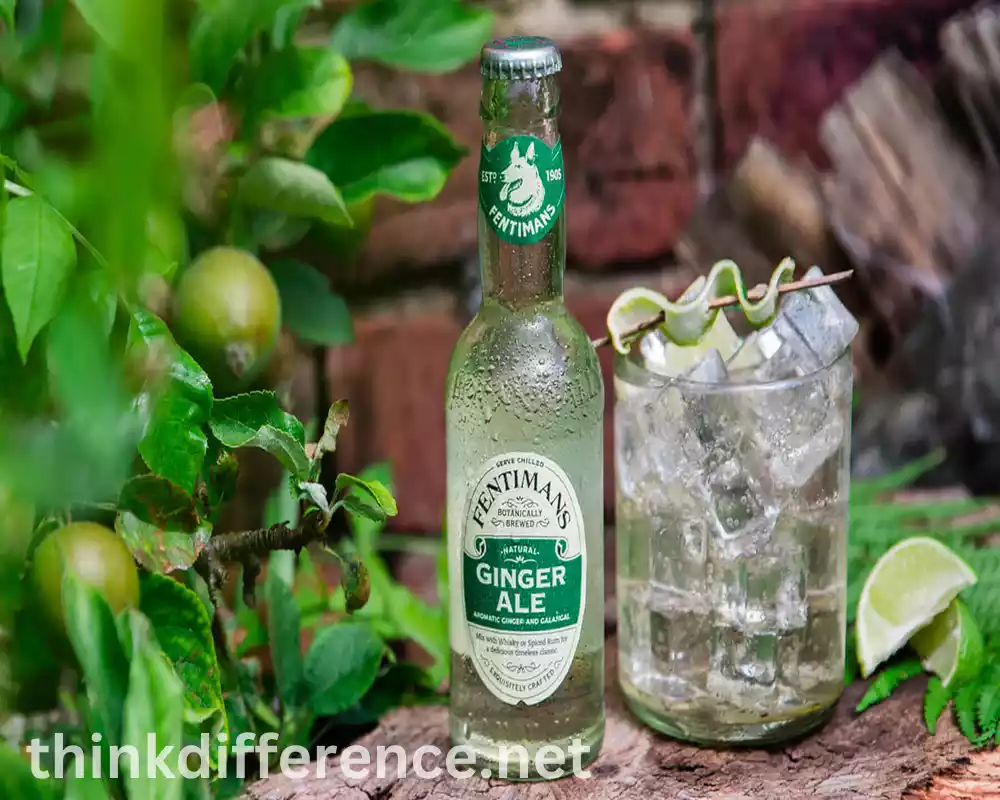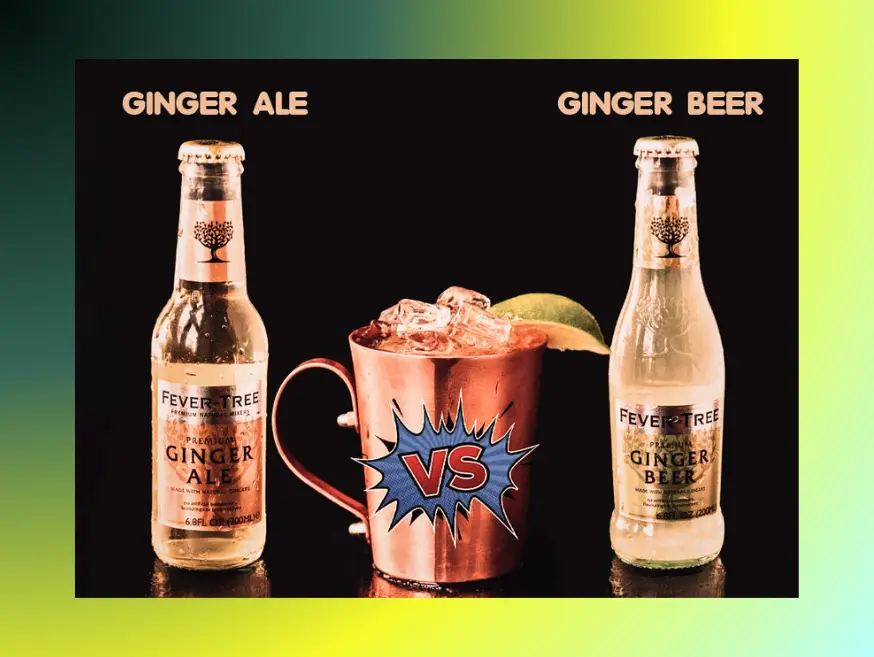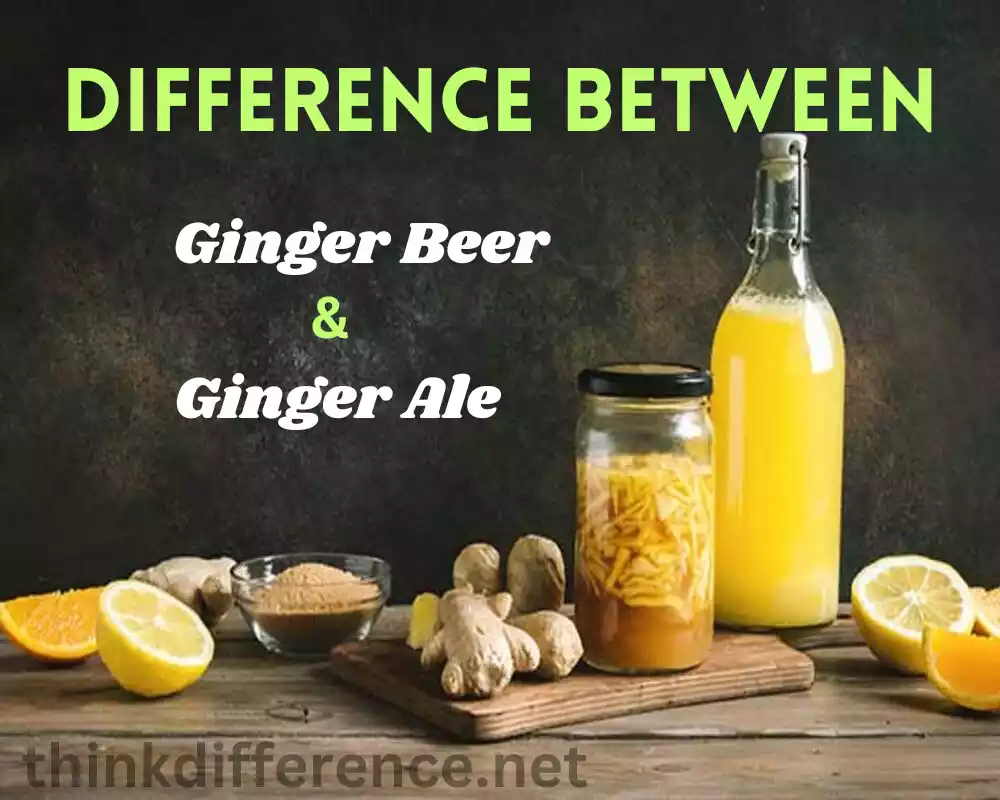Ginger Beer and Ginger Ale are globally beloved carbonated drinks with rich histories, signature flavors and numerous health benefits. In this article we’ll look into their history as well as explore their distinct characteristics, health advantages and how best to enjoy or make ginger-based drinks yourself.
Origins and History
Ginger Beer:
- Early use of ginger in brewing: Ginger was first used for its medicinal and flavorful qualities long ago. Eventually being fermented into a beverage which eventually formed the basis for ginger beer production.
- Ginger Beer’s Production Methods: Ginger beer first emerged as a non-alcoholic homemade beverage made by fermenting sugar, ginger and water together during England’s 18th-century heydays; its production techniques and recipes have since evolved over time to meet modern demand.
Ginger Ale:
- Ginger Ale’s History as a Nonalcoholic Beverage: Ginger ale became increasingly popular throughout Canada and United States during late nineteenth century as an alcohol-free alternative for beers or spirits such as whisky or wine. At first it was promoted as being healthier alternatives compared with their respective drinks such as alcohol-containing beverages like beer or cider.
- Popularity and Commercialization: Beginning in the late 19th Century, carbonation technologies enabled commercial production of ginger ale drinks. Due to its fizzy and refreshing qualities, many ginger ale brands were established; eventually becoming known by this name.
Ginger beer and ginger ale both boast unique histories and cultural associations. Ginger ale, with origins both in Ireland and England, is known for its milder flavour and fermentation process. Understanding their histories gives insight into their development as beverages with unique characteristics.
What is Ginger Beer?
Ginger beer is a carbonated drink flavored with ginger. To produce traditional ginger beer, ingredients including water, sugar and ginger root are used, along with starter cultures of bacteria and yeast to ferment the drink. Ginger beer’s rich history dates back centuries; many believe its invention took place during England’s 18th-century Golden Age.

Ginger beer doesn’t fit the traditional definition of beer as it contains no alcohol. There are versions with alcohol which may ferment. These fermented versions may be called brewed ginger beer and boast similar levels to light ales.
Ginger beer has an irresistibly spicy, zesty and slightly sweet flavor profile, depending on its recipe or brewing method. The intensity of ginger flavor varies with each drink recipe or method used; its bubbly fizziness makes it a highly anticipated beverage, enjoyed both as an individual beverage as well as part of cocktails such as Dark ‘n Stormy or Moscow Mule cocktails.
Ginger beer’s popularity has skyrocketed over recent years. Now available both as an artisan product and commercial one, ginger beer also provides non-alcoholic alternatives from certain brands to those looking for alcohol alternatives.
What is Ginger Ale?
Ginger ale is a carbonated soft drink that is also flavored with ginger. It is typically lighter and less spicy in flavor compared to ginger beer. Ginger ale a non-alcoholic version of ginger beer, was initially developed by Dr. Thomas Cantrell, an Irish pharmacist in the mid 19th Century.

Ginger ale contains ginger root, water, sugar and carbonated water as key components. Unlike ginger beer, ginger ale does not undergo a fermentation process. It is produced by mixing ginger flavoring, sweeteners, and carbonated water.
The flavor profile of ginger ale is milder and sweeter compared to ginger beer. It has a crisp, refreshing taste with a hint of ginger. Ginger ale is known for its versatility as a standalone beverage and as a popular mixer in various cocktails, such as the classic Whiskey Ginger or as a key ingredient in a Shirley Temple.
Most commercially available ginger ales are non-alcoholic, making them suitable for all ages. There are some alcoholic ginger ale variants on the market that contain a small percentage of alcohol.
Ginger ale is widely popular and can be found in numerous brands and variations, ranging from classic versions to diet or sugar-free alternatives. It is a common choice for those who prefer a lighter and less spicy ginger-flavored beverage.
Importance of understanding the difference between Ginger Beer and Ginger Ale

Reasons exist why it is vitally important to understand the differences between ginger beer and Ginger Ale, for various purposes:
- Flavor Profiles: Ginger beer and ginger ale have distinct flavor profiles. Ginger ale is more mild and sweeter than its counterpart, ginger beer. Understanding these flavor differences allows individuals to choose the beverage that aligns with their preferences and desired taste experience.
- Culinary Usage: Both ginger beer and ginger ale have culinary applications in recipes and beverages. Knowing their differences helps in selecting the appropriate one for specific recipes and achieving the desired flavor. For example, ginger beer’s bold flavor may be preferred in certain cocktails or spicy dishes, while ginger ale’s milder taste may be more suitable for delicate cocktails or baking recipes.
- Beverage Pairings: Understanding the differences between ginger beer and ginger ale can assist in selecting the right beverage for pairing with different foods or as mixers in cocktails. The distinct flavor profiles of each can enhance or complement the flavors of various dishes and spirits, allowing for more enjoyable culinary experiences.
- Dietary Preferences: Knowledge of the differences between ginger beer and ginger ale is crucial for individuals with specific dietary preferences or restrictions. Ginger beer may have variations that contain alcohol, making it unsuitable for those avoiding alcoholic beverages. Additionally, ginger ale may have diet or sugar-free options for individuals monitoring their sugar intake or following specific dietary plans.
- Cultural and Historical Context: Ginger beer and ginger ale have unique cultural and historical significance in different regions. Understanding the differences between the two beverages can provide insights into their origins, traditional brewing methods, and cultural importance. This knowledge adds depth to cultural experiences and appreciation of diverse culinary traditions.
- Personal Preferences: An understanding of the differences between ginger beer and ginger ale allows individuals to select an beverage that best meets their personal taste and preferences. By being aware of the distinctions, individuals can explore and enjoy a wider range of options, discovering new flavors and beverage experiences.
Understanding the difference between ginger beer and ginger ale is essential for making informed choices, enhancing culinary experiences, accommodating dietary preferences, appreciating cultural contexts, and satisfying personal tastes.
Ingredients and Flavor
Ginger Beer:
- Fermentation of Ginger beer: Ginger beer is traditionally brewed through a fermentation process. The main ingredients include ginger, sugar, water, and yeast. The yeast consumes the sugar and produces carbon dioxide, which gives the beverage its characteristic fizz.
- Use of real Ginger and other spices: Ginger beer is made by using large amounts of ginger root for an intense and spicy flavor, along with other spices like cloves, cinnamon to further add depth.
- Flavor profile of Ginger beer: Ginger beer is known for its robust and zesty flavor profile. It has a pronounced ginger heat and a spicy kick, often balanced by the sweetness of the sugar. The fermentation process can add a subtle tanginess and complexity to the overall taste.
Ginger Ale:
- Carbonation process of ginger ale: Unlike ginger beer, ginger ale is typically carbonated by injecting carbon dioxide into the beverage during production. This method creates a bubbly texture and effervescence.
- Use of artificial flavors and sweeteners: Ginger ale commonly relies on artificial flavors and sweeteners to achieve its taste. While some brands may still incorporate real ginger, the flavor is often milder and less pronounced compared to ginger beer.
- Flavor profile of ginger ale: Ginger ale has a lighter and smoother flavor profile compared to ginger beer. It is generally sweeter and less spicy, with a more subtle ginger taste. The carbonation provides a refreshing and crisp sensation.
The difference in ingredients and brewing methods significantly impacts the flavor of ginger beer and ginger ale. Ginger beer’s use of real ginger and the fermentation process results in a stronger, spicier, and more complex flavor profile.
Ginger ale relies on carbonation and artificial flavors, offering a milder, sweeter, and more effervescent taste experience. These distinctions in flavor make each beverage suitable for different preferences and culinary applications.
Alcoholic Content
Ginger Beer:
- Traditional alcoholic ginger beer: Historically, ginger beer was brewed as an alcoholic beverage. It was commonly brewed with a higher alcohol content due to the fermentation process. Modern commercially available ginger beers are often produced as non-alcoholic beverages.
- Alcoholic ginger beer as a mixer in cocktails: Some brands produce alcoholic ginger beer variants with a low to moderate alcohol content. These are often used as mixers in cocktails, providing a spicy and flavorful addition to drinks like the Moscow Mule or Dark ‘n’ Stormy.
Ginger Ale:
- Ginger ale as a standalone non-alcoholic beverage: Ginger ale can be enjoyed as an innocuous nonalcoholic drink. Traditional ginger ale contains no alcohol. It offers a refreshing ginger-flavored carbonated drink. Which can be enjoyed alone mixed with other non-alcoholic drinks for an enjoyable sipping experience.
Though both ginger ale and ginger beer may be found non-alcoholic today, ginger ale has historically been associated with higher alcohol contents than most commercial ginger beers available on shelves today. Most nonalcoholic ginger ales exist it’s important to check labels or select brands when searching for alcohol-containing varieties of either.
Carbonation Levels
Ginger Beer:
- Higher levels of carbonation: Ginger beer is typically naturally carbonated through the fermentation process. This can result in higher levels of carbonation compared to other carbonated beverages. The carbon dioxide produced during fermentation creates a bubbly and effervescent texture in the drink.
- Fermentation process and carbonation: During the fermentation of ginger beer, carbon dioxide is released as a byproduct. This carbon dioxide gets trapped within the liquid, resulting in the characteristic fizz and carbonation levels.
Ginger Ale:
- Lower levels of carbonation: Ginger ale generally has lower levels of carbonation compared to ginger beer. The carbonation in ginger ale is typically achieved through artificial methods, such as injecting carbon dioxide into the beverage during production. This can result in a less intense and more moderate level of carbonation.
- Carbonation methods used in ginger ale production: Ginger ale is carbonated using carbonation equipment or processes that allow controlled levels of carbon dioxide to be added to the beverage. This method ensures consistent carbonation levels across production batches.
The difference in carbonation levels between ginger beer and ginger ale affects the overall mouthfeel and sensation when consuming the beverages. Ginger beer, with its naturally higher carbonation, can provide a more lively and effervescent experience, while ginger ale offers a smoother and gentler carbonation. The choice between the two can depend on personal preference and the desired level of fizziness in a beverage.
Culinary Uses and Pairings
Ginger Beer:
- Use in cocktails and mixed drinks: Ginger beer is a popular ingredient in various cocktails, such as the Moscow Mule, Dark ‘n’ Stormy, and the Whiskey Ginger. Its spicy and robust flavor profile adds depth and complexity to mixed drinks.
- Marinades and glazes in cooking: Ginger beer can be used as a marinade or glaze for meats, particularly for grilling or barbecuing. The natural sweetness and ginger heat of the beverage can enhance the flavor of dishes like ginger beer-glazed chicken or pork.
Ginger Ale:
- Mixers in non-alcoholic beverages: Ginger ale is commonly used as a mixer in non-alcoholic cocktails or mocktails. It adds a gentle ginger flavor and carbonation to drinks like the Shirley Temple or the Classic Ginger Ale Punch.
- Flavoring in desserts and baked goods: Ginger ale can be incorporated into desserts and baked goods as a flavoring agent. It can add a subtle ginger note to recipes like ginger ale cakes, ginger ale sorbet, or ginger ale-infused fruit salads.
Both ginger beer and ginger ale offer versatility in culinary applications. Ginger beer’s stronger flavor profile makes it suitable for bold cocktails and savory dishes, while ginger ale’s milder taste lends itself well to refreshing mocktails and desserts. Choosing the right ginger-based beverage depends on the desired intensity of ginger flavor and the specific culinary purpose.
Popularity and Availability
Ginger Beer:
- Craft and artisanal ginger beer brands: Craft and artisanal brands of ginger beer have seen increased interest over the years. These brands focus on using high-quality ingredients and traditional brewing methods, catering to consumers looking for unique and authentic ginger beer experiences.
- Availability in specialty stores and online: While ginger beer was traditionally less widely available, it has become more accessible in specialty stores, gourmet markets, and online platforms. This increased availability allows consumers to explore a wider range of ginger beer options beyond mainstream brands.
Ginger Ale:
- Global distribution and market dominance: Ginger ale, being a long-established beverage, enjoys global distribution and market dominance. Product can be purchased in supermarkets, convenience shops and beverage retailers.
- Accessibility in supermarkets and convenience stores: Ginger ale is a staple in the soft drink aisle of supermarkets and is often found alongside other carbonated beverages. Its popularity and established presence contribute to its wide availability in both physical stores and online retail platforms.
Ginger beer, with its expanding craft market, has seen increased popularity among consumers seeking artisanal and unique flavors. Ginger ale maintains its widespread availability and market presence, making it easily obtainable for those seeking a familiar and readily accessible ginger-flavored beverage.
The availability of both beverages varies depending on the region, with more options likely to be found in areas with a diverse beverage selection or a growing craft beverage scene.
Health Benefits and Considerations
Ginger Beer:
- Digestive properties of ginger: Ginger, a key ingredient in ginger beer, has been associated with various digestive benefits. An antiemetics may help alleviate nausea, reduce indigestion and assist digestion.
- Anti-inflammatory and antioxidant effects: Ginger’s anti-inflammatory and antioxidant compounds offer numerous health advantages, including decreasing oxidative stress and inflammation within the body.
- Moderation and sugar content considerations: While ginger beer offers potential health benefits, it’s important to consider its sugar content. Some commercially available ginger beers may have high sugar levels, which should be consumed in moderation, particularly for individuals with diabetes or those watching their sugar intake.
Ginger Ale:
- Potential for soothing an upset stomach: Ginger ale has been traditionally used as a remedy for soothing an upset stomach or relieving nausea. The ginger flavor and carbonation can provide a calming effect on the digestive system.
- High sugar content and artificial ingredients: Commercially available ginger ale often contains high amounts of added sugars and artificial ingredients. Sugary drinks may lead to weight gain, dental decay and chronic illnesses. Opting for low-sugar or sugar-free varieties may be a healthier choice.
Ginger beverages should be seen in terms of an overall healthy and balanced lifestyle. While ginger offers potential advantages, it’s essential to be mindful of added sugars and artificial ingredients commonly found in commercial ginger ale.
Choosing natural, low-sugar, or sugar-free options and consuming ginger beverages in moderation can help maximize the potential health benefits they may offer. As with any dietary consideration, it’s advisable to consult with a healthcare professional or registered dietitian for personalized guidance.
Comparison table of Ginger Beer and Ginger Ale
Here’s a comparison table highlighting the key differences between Ginger Beer and Ginger Ale:
| Aspect | Ginger Beer | Ginger Ale |
|---|---|---|
| Origins and History | Originated in the 18th century as an alcoholic beverage. | Created in the mid-19th century as a non-alcoholic alternative. |
| Ingredients | Higher concentration of ginger, sugar, water, and sometimes other spices. | Milder ginger flavor, made with carbonated water, ginger flavoring or extracts, sugar, and sometimes citrus flavors. |
| Flavor | Bold, spicy, and robust. | Milder and sweeter, with a lighter ginger taste. |
| Alcoholic Content | Can vary from non-alcoholic to low to moderate alcohol content (less than 0.5% ABV), with some alcoholic versions available (around 4-8% ABV). | Typically non-alcoholic with negligible alcohol content. |
| Carbonation Levels | Higher carbonation levels, providing a pronounced fizziness. | Lighter and more subtle carbonation. |
| Culinary Uses | Standalone beverage and popular in cocktails like Moscow Mule and Dark ‘n’ Stormy. Used in marinades, glazes, sauces, and desserts. | Refreshing standalone drink, mixer in cocktails like Whiskey Ginger and Shirley Temple. Used in culinary applications and desserts. |
The Future of Ginger-Based Beverages
Ginger-based drinks like ginger ale and beer remain immensely popular, opening up exciting possibilities in their future development. Below are a few trends to look out for when purchasing such refreshing and versatile drinks:
- Innovation in flavors: While traditional ginger flavors remain popular, there is room for experimentation with new and unique flavor combinations. We may see the introduction of ginger-based beverages infused with fruits, herbs, spices, or even botanical extracts to offer a wider range of taste experiences.
- Craft and artisanal offerings: Craft breweries and small-scale producers have been gaining traction in the beverage industry. This trend may extend to ginger-based beverages, with artisanal ginger beers and ginger ales crafted using high-quality ingredients and traditional brewing methods. These small-batch creations can offer distinctive flavors and appeal to consumers seeking unique and premium options.
- Health-focused variations: With increasing consumer interest in wellness and healthier lifestyles, there may be a rise in ginger-based beverages that emphasize natural ingredients, lower sugar content, and functional benefits. We may see the introduction of ginger-based beverages enhanced with adaptogens, probiotics, or other natural additives known for their health-promoting properties.
- Non-alcoholic options: Since 2013, non-alcoholic and low alcohol beverages have seen increasing consumer adoption as people seek alternatives to traditional alcoholic drinks. Ginger-based beverages can cater to this trend by offering more non-alcoholic options or low-alcohol variations with unique flavors and sophisticated profiles.
- Sustainable packaging: As sustainability becomes a central focus in the beverage industry, the future of ginger-based beverages may involve eco-friendly packaging solutions. This could include options like recyclable or compostable bottles, innovative materials, or reduced packaging waste to minimize the environmental impact.
- Global fusion and cultural influences: Ginger is widely used in various cuisines around the world, and this diversity can inspire new flavors and combinations. The future may bring ginger-based beverages that draw inspiration from different cultural traditions, resulting in fusion creations that blend ginger with other ingredients and flavor profiles.
- Enhanced availability and accessibility: As ginger-based beverages gain more popularity, their availability and accessibility are likely to increase. These beverages will become more accessible to a larger consumer base by becoming available at grocery stores, specialty shops and online platforms.
The future of ginger-based beverages is promising, with potential for innovative flavors, health-conscious options, and sustainable practices. As consumer preferences evolve, manufacturers and craft producers will continue to explore new possibilities, pushing the boundaries of taste, quality, and sustainability. Whether it’s enjoying a classic Moscow Mule or experimenting with a unique ginger-infused creation, ginger-based beverages are poised to continue delighting taste buds and quenching thirsts for years to come.
Conclusion
Ginger Beer and Ginger Ale are more than just fizzy drinks; they are a delightful combination of sweetness and spiciness. From their intriguing origins to their versatile culinary and cocktail uses, these beverages have become favorites worldwide. Whether you enjoy them as a refreshing soft drink or mix them into exciting cocktails, Ginger Beer and Ginger Ale are here to stay.



